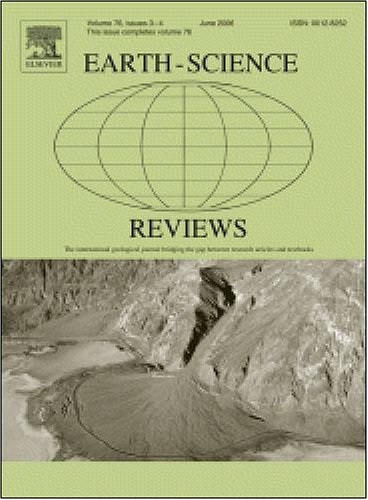Degassing of deep fluids in the Pannonian basin and adjacent areas
IF 10
1区 地球科学
Q1 GEOSCIENCES, MULTIDISCIPLINARY
引用次数: 0
Abstract
The Pannonian Basin (PB), in Central-Eastern Europe, is a continental area characterized by widespread presence of natural resources, high heat fluxes and outgassing of deep-sourced fluids (i.e. mantle-magma and/or crustal-derived). Moreover, the region is interested by ascent of the asthenosphere and a thin lithosphere (≈75 km). Here, we review 40 years of geochemical studies on natural gas emissions in the PB system and nearby areas providing the first comprehensive geochemical characterization of gas manifestations for the Croatian segment of PB. We use stable isotope (δ13CCO2) geochemistry, noble gases data, and C![]() He systematics to reconcile geochemical information with geophysical and geodynamic models at regional scale, and hence to characterize (i) the source/s of fluids outgassing at the surface and (ii) the main processes occurring during their storage in, and transit through, the crust.
He systematics to reconcile geochemical information with geophysical and geodynamic models at regional scale, and hence to characterize (i) the source/s of fluids outgassing at the surface and (ii) the main processes occurring during their storage in, and transit through, the crust.
The chemical composition of the emitted fluids is very heterogeneous in the PB. We identify three distinct gas types (CO2-dominated, N2-dominated, and CH4-dominated) that are variably distributed in different sectors of PB. The He isotopic composition range from 0.07 to 6.32Ra (Ra is the air He isotopic signature), suggesting the coexistence of crustal and mantle components in the area. Furthermore, the same components also occur in the Croatian PB, where the He isotopic ratios range from 0.02 Ra to 2.21 Ra. The groundwater circulation in the PB implies an addition of atmospheric-derived noble gas component to the deep fluids (mantle vs crust-derived). The volumetric gas/water ratios (Vg/Vl) are highly variable (0.002 to 66) with the highest values in N2-dominated samples, and correlate with atmospheric-derived 20Ne concentration, pointing to shallow gas origin for these samples (relative to CO2 and CH4-dominated samples). The C![]() He systematics, coupled with the δ13C of CO2, indicates extensive chemical and isotopic fractionation due to partial dissolution of gas in water in the shallow crustal layers and consequent CO2 trapping in deep aquifers and/or in precipitating carbonates. In addition, methanogenesis could work as an additional potential CO2 sink in the crust. The mantle-derived He flux, on a regional scale, is estimated at 1.7 × 1010 to 1.7 × 1012 atoms m−2 s−1, one order of magnitude greater than found by O'Nions and Oxburgh (1988), and similar to what found in other tectonically active regions. The mantle-related CO2 flux computed using CO2/3He ratios and the mantle He fluxes, range between 103 and 105 mol·km−2·year−1. Despite representing a rough estimation, these values are in the range of the CO2 fluxes in active and quiescent worldwide volcanic systems. We propose the transfer of mantle-derived volatiles to occurs through lithospheric faults in the PB and adjacent regions, although the presence of magmatic intrusions in crustal layers is an additional contributing factor.
He systematics, coupled with the δ13C of CO2, indicates extensive chemical and isotopic fractionation due to partial dissolution of gas in water in the shallow crustal layers and consequent CO2 trapping in deep aquifers and/or in precipitating carbonates. In addition, methanogenesis could work as an additional potential CO2 sink in the crust. The mantle-derived He flux, on a regional scale, is estimated at 1.7 × 1010 to 1.7 × 1012 atoms m−2 s−1, one order of magnitude greater than found by O'Nions and Oxburgh (1988), and similar to what found in other tectonically active regions. The mantle-related CO2 flux computed using CO2/3He ratios and the mantle He fluxes, range between 103 and 105 mol·km−2·year−1. Despite representing a rough estimation, these values are in the range of the CO2 fluxes in active and quiescent worldwide volcanic systems. We propose the transfer of mantle-derived volatiles to occurs through lithospheric faults in the PB and adjacent regions, although the presence of magmatic intrusions in crustal layers is an additional contributing factor.
潘诺尼亚盆地及邻区深部流体脱气研究
位于中东欧的潘诺尼亚盆地是一个大陆区域,其特点是自然资源广泛存在,热通量高,深源流体(即地幔岩浆和/或地壳源流体)脱气。此外,该地区对软流圈上升和薄岩石圈(≈75 km)感兴趣。在这里,我们回顾了40年来PB系统及附近地区天然气排放的地球化学研究,首次对PB克罗地亚段的天然气表现进行了全面的地球化学表征。我们利用稳定同位素(δ13CCO2)地球化学、稀有气体数据和CHe系统,将地球化学信息与区域尺度的地球物理和地球动力学模型相结合,从而描述(i)地表流体出气的来源和(ii)流体在地壳中储存和穿越过程中发生的主要过程。发射流体的化学成分在PB中是非常不均匀的。在PB的不同扇区中,我们发现了3种不同的气体类型(co2为主、n2为主和ch4为主)。He同位素组成范围为0.07 ~ 6.32Ra (Ra为空气He同位素特征),表明该区地壳和地幔组分共存。此外,同样的成分也出现在克罗地亚PB中,其He同位素比值在0.02 Ra至2.21 Ra之间。PB中的地下水循环意味着在深部流体中加入了大气衍生的稀有气体成分(地幔衍生与地壳衍生)。体积气/水比(Vg/Vl)变化很大(0.002 ~ 66),以n2为主的样品最高,与大气衍生的20Ne浓度相关,表明这些样品的气体来源较浅(相对于CO2和ch4为主的样品)。CHe系统和CO2的δ13C表明,由于地壳浅层部分气体溶解于水中,导致CO2被深层含水层和/或沉淀碳酸盐捕获,因此存在广泛的化学和同位素分馏。此外,甲烷生成可以作为地壳中额外的潜在二氧化碳汇。在区域尺度上,地幔衍生的He通量估计为1.7 × 1010至1.7 × 1012原子m−2 s−1,比O'Nions和Oxburgh(1988)发现的大一个数量级,与其他构造活跃区域的发现相似。利用CO2/ 3he比值和地幔He通量计算的地幔相关CO2通量在103 ~ 105 mol·km−2·年−1之间。尽管这是一个粗略的估计,但这些值在全球活跃和静止火山系统的CO2通量范围内。我们认为地幔源挥发物的转移是通过PB和邻近地区的岩石圈断层发生的,尽管地壳层中岩浆侵入的存在是一个额外的因素。
本文章由计算机程序翻译,如有差异,请以英文原文为准。
求助全文
约1分钟内获得全文
求助全文
来源期刊

Earth-Science Reviews
地学-地球科学综合
CiteScore
21.70
自引率
5.80%
发文量
294
审稿时长
15.1 weeks
期刊介绍:
Covering a much wider field than the usual specialist journals, Earth Science Reviews publishes review articles dealing with all aspects of Earth Sciences, and is an important vehicle for allowing readers to see their particular interest related to the Earth Sciences as a whole.
 求助内容:
求助内容: 应助结果提醒方式:
应助结果提醒方式:


